ICP Analysis
An overview of Inductively-Couple Plasma (ICP) Spectroscopy or ICP Analysis which is a fundamental test in any oil analysis program.
Spectroscopy is the primary test in commercial oil analysis laboratories. All samples, with few exceptions, receive elemental analysis. Commerical oil analysis laboratories analyse for 30 or more elements that detect wear (i.e. iron, chromium, copper), indicate the ingression of contaminants (i.e. silicon, potassium) and characterize the fluid in use (i.e. calcium, phosphorus, zinc). As components wear they generate small benign wear particles less than 10 microns in size. These particles can be detected and analysed by ICP. These benign particles increase in concentration when abnormal wear is occuring, in most wear modes. ICP spectroscopy is highly reproducible and lends itself well to trend analysis (monitoring the increases in elemental levels caused by abnormal wear). These principles form the basis of a spectroscopic oil analysis program (SOAP).
Many contaminants, ingressed from the operating environment, contain signature elements that can be detected by ICP spectroscopy. Dirt is comprised of alumina-silicate which the ICP detects as aluminum (Al) and silicon (Si). Cooling chemicals ingressing into an engine leave tell-tale signatures of potassium (K), sodium (Na) and possibly boron (B). ICP spectroscopy is an effective means of detecting unwanted contaminant ingression in lubricated systems.
Lubricating oils and greases contain additives that contain organo-metallic molecules and metallic hydroxides such as phosphorus (P), calcium (Ca), zinc (Zn). ICP spectroscopy provides analysis of these elements that produces a signature of the lubricant in use. This signature can be used to detect improper top-ups, or determine what lubricant is in use. Taken together ICP spectroscopy provides a simple and comprehensive assessment of the condition of the machine and lubricant.
A 1ml sample of oil is diluted 9:1 and analyzed by an Inductively-Couple Plasma Spectrometer (ICP). The sample travels into an aerosol chamber and to the torch where the sample is atomized in a plasma flame. The plasma ‘flame’ has been generated using a radio frequency generator to activate a coil surrounding the torch. The resultant ‘flame’ is extremely hot [which gives ICP great sensitivity at low levels of detection]. As a corollary to absorption principles, ICP causes photon emission of light energy [usually in the ultraviolet range for most elements] and measures that emission’s intensity to determine the amount of the target element. The light energy is the result of each atom’s return to a more stable state after having one or more of its electrons driven out of its normal orbit.
Emitted energy is routed to a diffraction grating and then to a photomultiplier tube, or possibly a CCD* [charge coupled device]. The grating acts like a prism and cleaves or ‘fans’ the light into discrete wavelengths. These wavelengths come off the grating at precise, but different angles, allowing a discrete detector [the PM-tube or CCD] to be placed in the light path for each element of interest. The instrument detects the wavelengths of emitted light to measure thirty (30) or more elements present in the sample. Where ICP provides great advantage is that the entire array of elements of interest is analyzed for simultaneously, greatly shortening the analytical time.
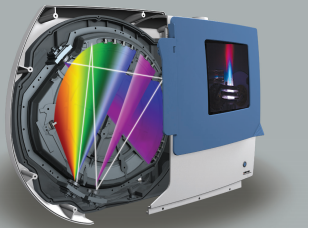
Figure - A modern ICP Spectrometer (courtesy Ametek/Spectro)
Most commercial oil analysis laboratories utilize Inductively-Coupled Plasma (ICP) Spectrometers as part of their oil analysis program. ICP Spectroscopy reveals the elemental make-up of the oil sample, revealing information about the additive package, contaminants, and wear metals. The results obtained from ICP Spectroscopy are reported in parts per million (ppm) ( 10,000 ppm = 1% ).
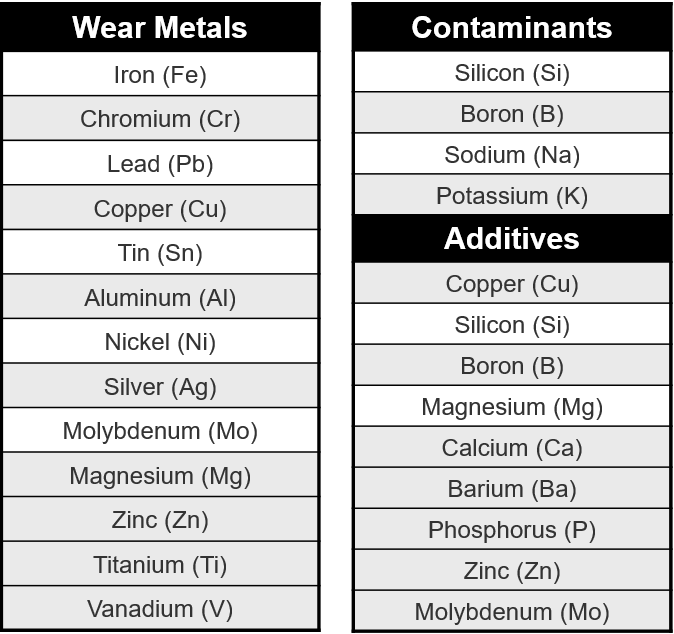
Figure - Typical elements analysed by an ICP spectrometer by a commerical oil analysis laboratory
Commercial oil analysis laboratories configure their ICP spectromters to measure elements that indicate the presence of wear (such as iron, chromium, copper, aluminum) and contaminants (such as silicon and potassium) in used oil, as well as for detecting the elements present in oil additives (such as phosphorus and zinc).
The wear metal chart shows an increase in the tin (Sn) level that returned to normal levels after the oil change, however the lead level continued to rise. The additive levels, specifically phosphorus (P) and sulphur (S), had changed significantly indicating a top-up with different oil had most likely occurred.
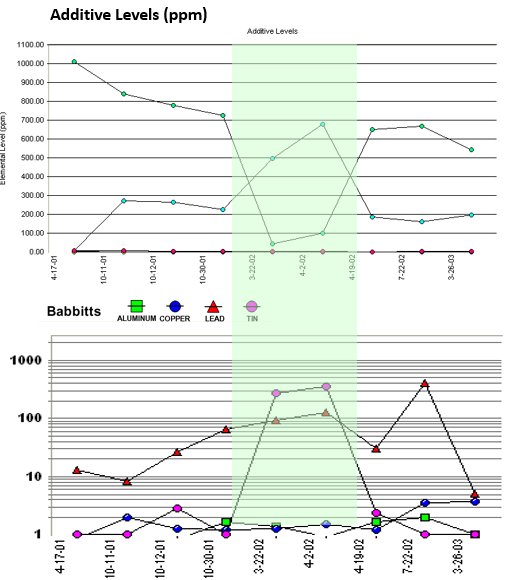
Figure - Additive levels of phosphorus and sulphur (top graph) had changed dramatically. Tin levels increase dramatically (lower graph) at the same time.
Based on the oil analysis findings the Plant Mechanical Engineer made the decision to take the 2.5 MW hydroelectric generating unit out of service in order to inspect the bearings on the turbine main horizontal shaft. The main shaft is roughly 10” in diameter with the collars being an inch or 2 greater. The inspection showed that an area of delamination (babbitt had flaked away from the bearing backing) on the #2 thrust bearing.
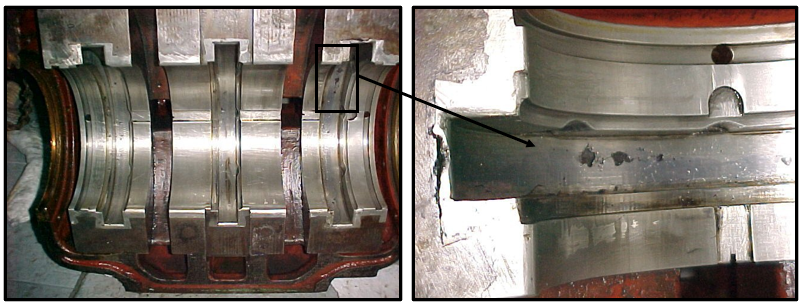
Figure - The main bearing (left) exhibits delamination of the Babbitt overlay (inset picture on right).
It was decided that the bearing would be put back into operation and repaired at the next shut-down since that outage was to be longer and would provide the necessary time to repair the bearing. The oil was changed and the unit was put back in service. Unfortunately, as the bearing began to fail, the vibration in the power turbine unit became so excessive that it shook the plant and caused several machines to move on their mountings. The end result was a forced shut-down of the plant for three months to re-mount all the equipment (and to repair the thrust bearing on this power unit).
With reciprocating machinery, such as a diesel engine, the wear particles generated tend to be small (<10 microns). As a result, ICP analysis can easily pinpoint the specific wear modes and conditions of the machine.
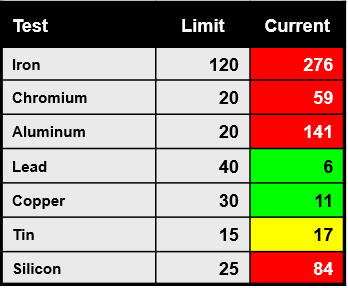
Figure - ICP analysis is excellent at pinpointing wearing components and ingressed contaminants.
This oil sample is from a Detroit 6V71 diesel engine. The iron (cylinders), chromium (rings), aluminum (piston), and tin (piston flashing) levels are abnormal to severe. The silicon (dirt) level is also severe. The diagnosis is that high dirt levels are creating severe cylinder assembly wear.
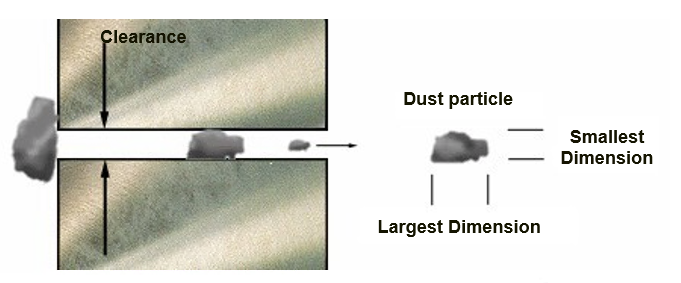
Figure - Dirt particles that fit between the clearances in components interrupt the lubricant film and cause wear to the machinery. Dirt particles can actually lodge into soft metals and proceed to carve out metal from opposing component surfaces.
If the dirt ingression was not severe a simple oil, oil filter and air filter change following an oil flush may correct the situation. If there was significant coarse dirt ingression then it may be necessary to do a bottom-end overhaul to replace the engine main bearings.